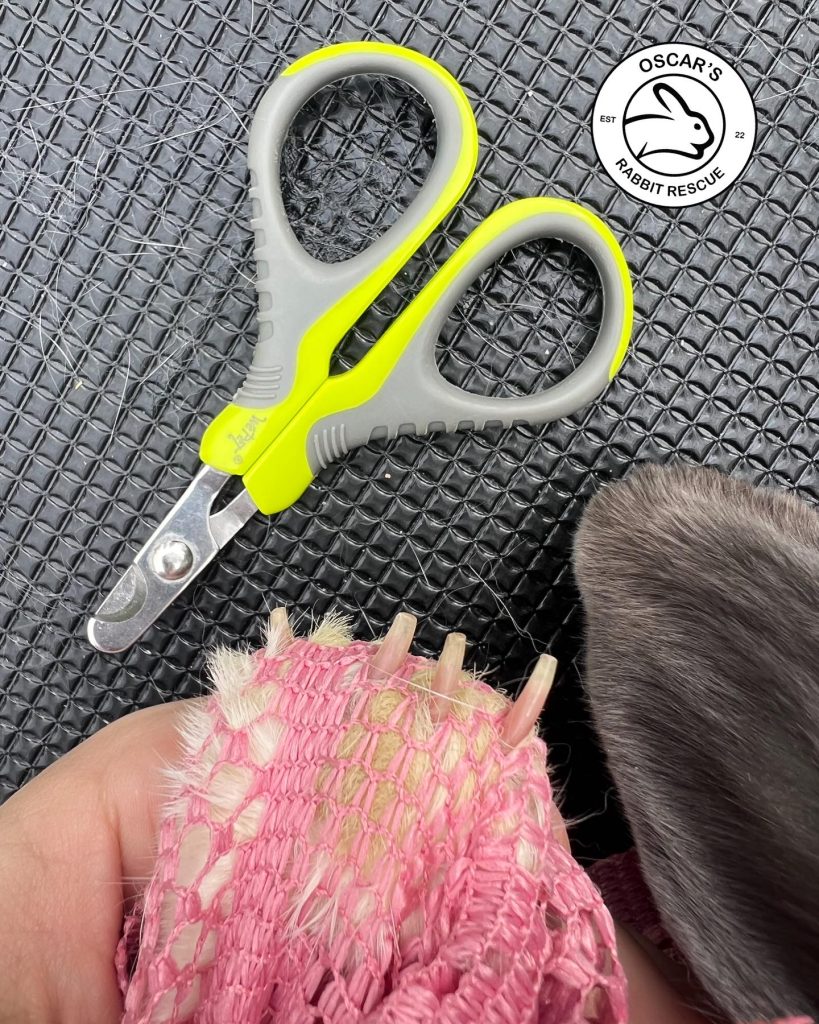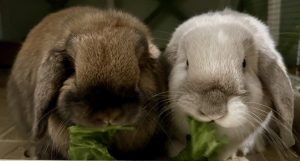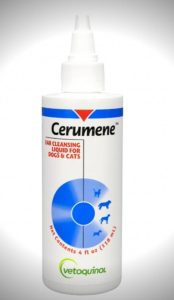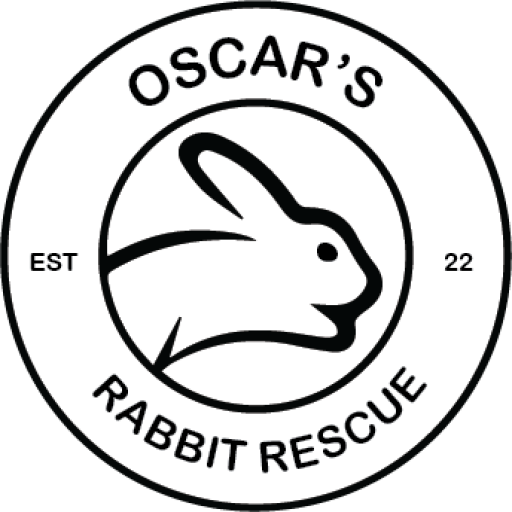Rabbits are naturally one of the cleanest animals. When healthy and provided the proper environment, they will keep themselves quite clean. However, there are areas that we need to help them with.
Nail Trimming
 Toe injuries are the most common injury we see on rabbits that we take into our rescue. Untrimmed toenails are the the leading cause of toe injuries. Grates used in cages and litter boxes also commonly cause injuries. Long nails can also cause permanent deformity to toes.
Toe injuries are the most common injury we see on rabbits that we take into our rescue. Untrimmed toenails are the the leading cause of toe injuries. Grates used in cages and litter boxes also commonly cause injuries. Long nails can also cause permanent deformity to toes.
Nail Trimming Tips
1. Safely secure your rabbit to avoid injury. If your bun fights, wrap him/her in a towel to prevent injury from jumping, dropping, or kicking.
2. Use lace to easily see the nails.
3. Use light pressure with the scissors and if they flinch don’t clip there.
Trim nails every few weeks to help prevent discomfort and broken toes.
Purchase a nail clipper HERE
Brushing & Molting
MOLTING / MOULTING
Molting is natural. It is when the rabbit’s fur is shed and replaced with new fur. In adult rabbits it typically happens in Spring and Fall. Some breeds molt more noticeably than others, and you may notice some smaller molting at other times of the year. Rabbits under 1 year old will molt around 5-6 weeks old and again around 4-5 months old.
BRUSH YOUR RABBIT
Help your rabbit from ingesting too much fur by gently brushing your rabbit. Hair that is ready to come out can also be gently pulled out. Rabbit skin is very delicate and will tear easily. Be very careful when brushing, choosing brush types, pulling too hard, and cutting with scissors.
Our favorites: Buster Comb (seen above) and a Small Comb *plastic tips*
Exception: Angora wool grooming should be done with a blowing technique rather than regular combing. Combs can cause breakage in the wool that can lead to more matting of the fur. This can be done with a gentle vacuum or a hair dryer (avoid overheating the rabbit).
Hair mats cause pain by pulling on the skin. This also restricts the rabbit’s ability to move.
Hair mat comb
RISKS OF MOLTING
For some, heavy molting can be taxing and cause the rabbit to not want to eat as much as usual. It is very important to prevent GI stasis during this by monitoring poops as well as food and water intake. Act quickly if noticing changes. GI stasis kills many rabbits daily, and it happens fast.
Ingested hair can clog the stomach or intestines by creating a hard ball called trichobezoar. We must be aware that the rabbit can not vomit, so it cannot expel the ball of hair. The acidity of the stomach is not great enough to disintegrate it. We must stop it from happening and act quickly if it does happen.
The observation of poop is very important:![]() If they are connected together forming a kind of rosary, you must be vigilant.
If they are connected together forming a kind of rosary, you must be vigilant.![]() If the size of the droppings gradually decreases you must be vigilant.
If the size of the droppings gradually decreases you must be vigilant.![]() If your rabbit does not want to eat anymore!
If your rabbit does not want to eat anymore!![]() If your rabbit makes a ball in a corner, or other signs of pain, CAUTION
If your rabbit makes a ball in a corner, or other signs of pain, CAUTION
More about GI Stasis HERE
WHEN IN DOUBT, GET HELP!
![]() ACT FAST – with a rabbit you have to act very fast when there is a concern. You must have an emergency rabbit savvy vet plan and an emergency kit (see here for a DIY kit).
ACT FAST – with a rabbit you have to act very fast when there is a concern. You must have an emergency rabbit savvy vet plan and an emergency kit (see here for a DIY kit).
A list of some rabbit savvy vets can be found HERE
PREVENTION![]() Brush and monitor your rabbit
Brush and monitor your rabbit![]() Feed a diet rich in fiber (Timothy hay) – hay stimulates the gut to work and keep food moving
Feed a diet rich in fiber (Timothy hay) – hay stimulates the gut to work and keep food moving![]() Feed appropriate amounts of vegetables that increase hydration (e.g., romaine lettuce, cilantro)
Feed appropriate amounts of vegetables that increase hydration (e.g., romaine lettuce, cilantro)![]() Water bowls (NO bottles)
Water bowls (NO bottles)![]() Daily exercise outside of an enclosure helps stimulate the gut
Daily exercise outside of an enclosure helps stimulate the gut![]() Prevent chewing on things like cords and towels that can create a blockage that is a true emergency
Prevent chewing on things like cords and towels that can create a blockage that is a true emergency
Cleaning Scent Glands
Scent glands are located on both sides of a rabbit’s genitals and under their chin. It is important to regularly check the scent glands near the genitals because they can form a build up in them of a waxy substance. Check these at least once a month.
How to Clean Scent Glands:
- Dampen a cotton swab or q-tip with warm water or baby oil.
- Be gentle. Hold your rabbit securely and comfortably, supporting the back and in an upright position.
- Gently wipe away the waxy substance. Be patient while doing this and be careful. The skin around the scent glands is very thin and fragile.
If you think there is an infection, take your rabbit to a rabbit-savvy vet.
Bathing
DANGEROUS
Rabbits are naturally clean and should not require bathing unless it is an emergency. A bath may stress the rabbit to the point of shock or heart failure or cause hypothermia/death if not properly dried.
If cleaning is necessary, try spot cleaning or consult a vet.
Ear Cleaning

Ear infections in rabbits are hard to treat and can quickly become fatal as infection spreads causing bone destruction and neurological deficits.
Immediately consult a vet if you notice behavior changes, pain symptoms, decreased eating or pooping, head tilt, flickering eyes, or other concerns.
Causes:
Lop eared rabbits are at high risk because of an anatomical defect of their ear cartilage which can only be corrected through surgery. Additionally, they cannot clean their own ears well. Cerumen build up plus their ear canal shape and small size leads to ear infections. Lops have droopy ears, smaller ear canals, and an L-shaped ear canal that can prevent detection of ear infections by just looking into the ears with an otoscope. Ear infections typically become chronic, and typically need recurrent antibiotic therapy. Many lop rabbits go on to have a very expensive, invasive procedure called a partial ear canal ablation – bulla osteotomy or PECA-BO.
Other causes: Poor environment, long nails, genetics, etc.
Prevention
1. Routine vet care and exams. Despite all prevention attempts, ear infections may happen anyway.
2. Clean lop eared rabbit ears every 1-2 weeks (frequency & other breed needs can vary based on each rabbit’s needs).
3. Maintain a clean environment.
4. Trim nails regularly.
How to Clean Ears:
- Pour a small amount of solution in the ear.
Vet recommended solutions to help dissolve wax: 1) Cerumene, 2) EpiKlean. - Massage the base of the ear.
- Do not stick anything into the ear, but you may gently wipe with a cotton ball if needed.
Ear infections must be detected and treated early. Failure to treat leads to severe pain and death because the infection spreads.

- ~Bringing Home a Pet Rabbit~
- ***Diet for a Domestic Rabbit
- Activities
- Ages & Stages of Life
- Baby Bunnies
- Bonding Rabbits
- Emergency Preparedness
- Ear Cleaning
- Enrichment Activities
- GI Stasis in Rabbits
- Grooming & Nail Trimming
- Household Hazards
- Litter & Litter Boxes
- RHDV-2
- Spay & Neuter
- Supplies
- Vets for Your Rabbit
- Wild Bunnies
- Bearded Dragons
- Guinea Pig Guide
- Blog
